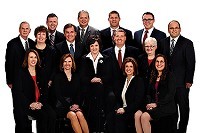YOUR BUSINESS AUTHORITY
Springfield, MO
YOUR BUSINESS AUTHORITY
Springfield, MO

When making planning decisions, you should consider all factors and make sure that everyone on your team has a voice.
Investment advice, estate planning, and income tax planning are deeply intertwined, or should be. Why is this the case?
• An investment decision shouldn’t be made without considering the income tax impact. This means the portfolio manager needs to be talking to your tax advisor. They must know if you are subject to the surtax, what income tax bracket you are in and if you have any losses carried forward. Only an informed investment advisor can make decisions that are truly in your best interest. What will be the tax bracket going forward? Are there likely to be years with excessive income/capital gains and ones with low income/capital gains?
• Do you have low basis assets? Should you hold or sell? How do you plan for this? Does the investment advisor know how this will impact your long term estate planning? Evaluate whether a Credit Shelter Trust (CST) makes sense. A properly designed CST will shelter appreciation of assets from the estate tax after the death of the first spouse. However, since the portability provision allowing a surviving spouse to utilize the unused exemption amount of a deceased spouse is permanent, is trust planning actually necessary? There are some benefits for still utilizing a credit shelter trust including protection of assets from potential creditors, spendthrift protection for trust beneficiaries, planning for state death taxes, and preserving the Generation Skipping exemption, which is not portable. However, costs and effort are required to establish the trust while the portability provision does not involve any special planning. Additionally, assets transferred to a trust at the death of the first spouse do not receive a “step-up” in cost basis at the death of the second spouse.
• Does your estate planning attorney know that a significant part of your portfolio is in low basis assets? It could impact their recommendation.
• Where should I locate my assets? Asset “location.” Allocate assets by tax status. Should you consider placing a larger percentage of your stock holdings outside of retirement accounts and a larger percentage of your fixed-income holdings inside retirement accounts? With respect to stock investments, allocating a greater proportion of your buy-and-hold or dividend-paying investments to taxable (i.e., non-retirement) accounts may increase your ability to benefit from a lower tax rate on qualified dividends and long-term capital gains.
These are only a very few examples of why it is important to make sure you have comprehensive planning. Consideration of income tax impact, estate planning outcomes and selection and funding of investments can have a big impact on your nest egg.
You should have a team made up of your estate planning attorney, your CPA, and your portfolio manager/trust officer. All of these team members have key pieces of advice and a different relationship with you. Make sure all of these advisors are fee based and are independent of each other (do not work for the same company) – this avoids a potential conflict of interest and makes certain the team is batting for you! Bringing the team together creates comprehensive planning and insures the best results.
Evergreen Hair House opened; the Ozark Chamber of Commerce moved to a new home; and Dirk’s Tavern LLC got its start on C-Street.